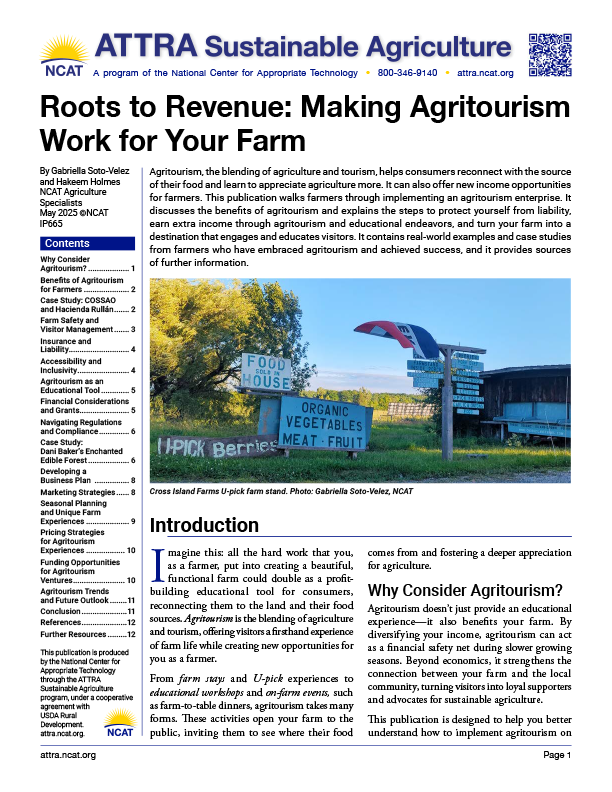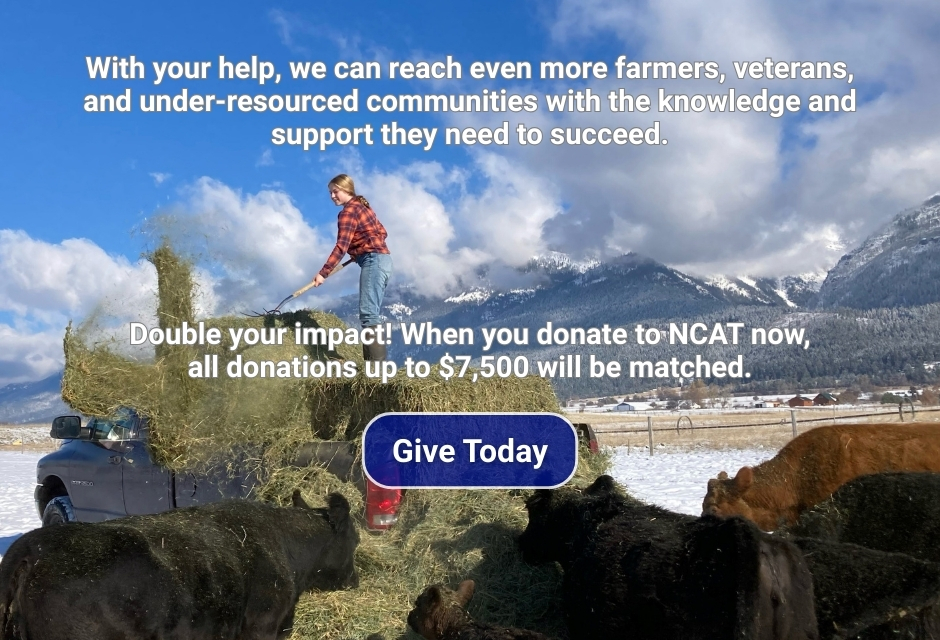Roots to Revenue: Making Agritourism Work for Your Farm

Cross Island farms U-pick farm stand. Photo: Gabriella Soto-Velez, NCAT
By Gabriella Soto-Velez and Hakeem Holmes, NCAT Agriculture Specialists
Agritourism, the blending of agriculture and tourism, helps consumers reconnect with the source of their food and learn to appreciate agriculture more. It can also offer new income opportunities for farmers. This publication walks farmers through implementing an agritourism enterprise. It discusses the benefits of agritourism and explains the steps to protect yourself from liability, earn extra income through agritourism and educational endeavors, and turn your farm into a destination that engages and educates visitors. It contains real-world examples and case studies from farmers who have embraced agritourism and achieved success, and it provides sources of further information.
Contents
Introduction
Why Consider Agritourism?
Case Study: COSSAO and Hacienda Rullán
Farm Safety and Visitor Management
Insurance and Liability
Accessibility and Inclusivity
Agritourism as an Educational Tool
Financial Considerations and Grants
Navigating Regulations and Compliance
Case Study: Dani Baker’s Enchanted Edible Forest
Developing a Business Plan
Marketing Strategies
Seasonal Planning and Unique Farm Experiences
Pricing Strategies for Agritourism Experiences
Funding Opportunities for Agritourism Ventures
Agritourism Trends and Future Outlook
Conclusion
References
Further Resources
Introduction
Imagine this: all the hard work that you, as a farmer, put into creating a beautiful, functional farm could double as a profit-building educational tool for consumers, reconnecting them to the land and their food sources. Agritourism is the blending of agriculture and tourism, offering visitors a firsthand experience of farm life while creating new opportunities for you as a farmer.
From farm stays and U-pick experiences to educational workshops and on-farm events, such as farm-to-table dinners, agritourism takes many forms. These activities open your farm to the public, inviting them to see where their food comes from and fostering a deeper appreciation for agriculture.
Why Consider Agritourism?
Agritourism doesn’t just provide an educational experience—it also benefits your farm. By diversifying your income, agritourism can act as a financial safety net during slower growing seasons. Beyond economics, it strengthens the connection between your farm and the local community, turning visitors into loyal supporters and advocates for sustainable agriculture.
This publication is designed to help you better understand how to implement agritourism on your farm successfully. We’ll walk you through the steps to protect yourself from liability, earn extra income through agritourism and educational endeavors, and turn your farm into a destination that engages and educates visitors. Along the way, we’ll share real-world examples and case studies from farmers who have embraced agritourism and achieved success. Whether you’re exploring agritourism for the first time or looking to expand your current offerings, this guide provides actionable insights and inspiration to help you move forward confidently.
Benefits of Agritourism for Farmers
Agritourism offers numerous advantages for farms, ranging from increasing and diversifying revenue to buffering economic shocks. It also provides opportunities for direct-to-consumer sales, adds value to farm products, and fosters stronger community ties through educational events and on-farm experiences. One excellent example of this holistic agritourism model is COSSAO’s Hacienda Rullán in Utuado, Puerto Rico.
Case Study: COSSAO and Hacienda Rullán – Building Agritourism for Community Resilience in Puerto Rico
Development of Utuado (COSSAO) has demonstrated how agritourism can drive economic resilience and community well-being, particularly during challenging times. Following the devastation of Hurricane Maria in 2017, COSSAO emerged as a key organization, leveraging local resources and external funding to rebuild the region’s agricultural economy through agritourism initiatives. COSSAO, founded in 2013, has a history of addressing socioeconomic challenges in Utuado through health services, disaster recovery, and agricultural development, uniquely positioning it to lead these efforts.
Background and Challenges Faced
Puerto Rico has long grappled with systemic challenges in its agricultural economy, including limited local food production and a reliance on imported goods. Hurricane Maria further exposed these vulnerabilities, leaving communities like Utuado without essential services for extended periods (Weingarten et al., 2023). The delayed governmental response underscored the need for self-sufficient, community-driven economic models.
COSSAO’s Agritourism Initiative
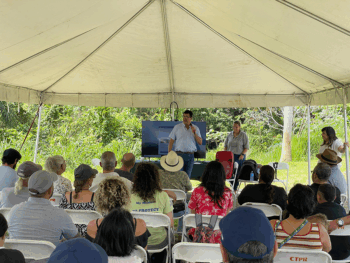
Tito Valentin, President of COSSAO, discusses agritourism with local farmers at Hacienda Rullan, Puerto Rico. Photo: Dr. Patrick Holladay, Troy University
In response, COSSAO acquired Hacienda Rullán, a historic coffee-roasting facility on 13 acres of agricultural land in the barrio of Tetuán III, with the vision of transforming it into a multipurpose agritourism destination. The property now features an agricultural education center, a food hub for low-cost local food distribution, aquaculture systems, and a medicinal garden and is establishing a new campground for visitor stays, blending cultural preservation with sustainable income generation (Holladay et al., 2019).
The project’s success was amplified through strategic partnerships with the University of Puerto Rico, Troy University, and funding from grants, including a Southern Sustainable Agriculture Research and Education (SSARE) grant (Holladay et al., 2021). These collaborations supported infrastructure improvements, disaster-resilience strategies, and farmer-training programs, all of which reinforce long-term sustainability.
Economic and Community Benefits
By emphasizing agritourism, COSSAO diversified its income streams and reduced reliance on traditional farming revenue. Hiking, camping, birding, guided farm tours, and workshops on sustainable farming practices have attracted both tourists and locals, generating supplemental income while engaging the community in educational activities. The model has also contributed to increased food security and reduced dependency on imported goods by promoting local food production (Weingarten et al., 2023).
Sustainability and Risk Management
COSSAO has prioritized sustainability by integrating agritourism with regenerative agricultural practices, such as coffee agroforestry and permaculture techniques. These methods enhance soil health, improve water retention, and increase biodiversity, all while educating visitors about sustainable agriculture (Holladay et al., 2019).
To address risk management, COSSAO established clear safety protocols to ensure a secure experience for guests. Liability waivers and professional guidance further support the project’s long-term sustainability and legal compliance.
Key Takeaways and Lessons Learned
- Collaboration Matters: Partnerships with universities and government agencies were crucial in securing funding and technical assistance. Leveraging these relationships allowed COSSAO to access technical expertise with, for example, disaster preparedness and agritourism development and marketing, both of which have been critical to its agritourism success.
- Income Diversification: Agritourism activities like farm tours and workshops provided income stability while preserving cultural heritage.
- Community Empowerment: Local participation in the design and implementation of projects fostered resilience and self-reliance. COSSAO engaged more than 50 community members in planning workshops, focus groups, and farm visits, ensuring that the initiative aligned with local needs and priorities.
COSSAO’s work at Hacienda Rullán exemplifies how agritourism can drive both economic development and community resilience. By combining sustainable agricultural practices with cultural heritage and tourism, the initiative provides a model for other rural communities seeking to build resilience through diversified income and educational outreach.
Farm Safety and Visitor Management
Safety is the cornerstone of any successful agritourism venture. Inviting the public onto your farm requires a proactive approach to managing risks and ensuring the well-being of your visitors. Adhering to local, state, and federal health and safety regulations is crucial for protecting both guests and farm owners. Installing sturdy fencing around hazardous areas such as ponds, machinery, or animal enclosures helps restrict access and prevent accidents. Clear and consistent signage is equally important, guiding visitors to designated areas while providing warnings about potential risks. Developing and enforcing safety protocols tailored to your farm’s specific activities—such as U-pick operations or hayrides—can further minimize potential hazards (OSHA, No date).
Risk management is an ongoing process. Regular safety audits allow you to identify potential issues, from uneven terrain to improperly secured equipment. These audits should be coupled with staff training to ensure everyone on your team understands how to maintain a safe environment. Additionally, providing well-maintained facilities, such as clean restrooms, accessible parking areas, and comfortable seating spaces, enhances the visitor experience while reducing safety concerns. Resources from organizations like OSHA offer valuable guidance on maintaining safety standards specific to agricultural operations (OSHA, No date).
Insurance and Liability
Navigating the legal complexities of agritourism requires careful planning, particularly regarding insurance and liability. Many standard farm insurance policies do not cover public-facing activities, leaving farms exposed to potential risks. Consulting with insurance providers to secure coverage tailored to agritourism is essential. Policies should encompass liability for visitor injuries, property damage, and specific activities unique to your operation (Farm Commons, no date).
While insurance provides financial protection, liability waivers can offer an additional layer of security. A well-drafted waiver outlines the inherent risks of participating in farm activities and requires visitors to acknowledge their understanding. However, waivers are not foolproof and may not absolve all legal responsibilities. Farm Commons recommends consulting an attorney to draft legally enforceable documents (no date).
Understanding and complying with local zoning laws and permits is equally important. Agritourism activities may be subject to land-use restrictions, noise ordinances, or other regulations that vary by jurisdiction. Ensuring your farm aligns with these requirements can help avoid legal complications and maintain a positive relationship with your community (Retzlaff, 2004).
Accessibility and Inclusivity
Making your farm accessible and inclusive is not only good practice but also a way to ensure that a broader audience can enjoy the agritourism experience. Accessibility begins with meeting the requirements of the Americans with Disabilities Act (ADA). This involves providing features such as ramps, accessible restrooms, and pathways that accommodate individuals with mobility challenges. Thoughtful design choices, such as clear signage and smooth surfaces, can make a significant difference for visitors with disabilities (National AgrAbility Project, no date).
Inclusivity goes beyond physical accessibility to consider the diverse cultural and linguistic backgrounds of your audience. Offering materials in multiple languages or providing bilingual staff can help make all visitors feel welcome. Designing programs that are sensitive to cultural norms and expectations further enhances the visitor experience. By fostering an environment where everyone feels valued, you not only expand your potential customer base but also create a more meaningful connection between your farm and its visitors (National AgrAbility Project, no date).
The following organizations specialize in farm safety and visitor management. By leveraging the expertise of these organizations, you can create a safe and enjoyable agritourism experience while ensuring your farm complies with industry best practices.
Occupational Safety and Health Administration (OSHA): Offers guidelines for signage, fencing, and hazard management to ensure safety on agricultural operations.
Farm Commons: Provides legal resources, including liability waivers, safety protocols, and advice on managing visitor safety.
National Children’s Center for Rural and Agricultural Health and Safety: Focuses on creating safe environments for families and children visiting farms.
National AgrAbility Project: Supports accessible farming operations and visitor facilities with practical design solutions.
Local Cooperative Extension Offices: Offer workshops and publications specific to agritourism safety and visitor management.
Agricultural Safety and Health Centers (NIOSH): Provide regional support for farm safety, including emergency protocols and public health resources.
Agritourism as an Educational Tool
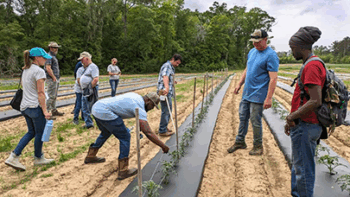
Moccasin Grove Farm in Tallahassee, Florida, hosts an educational farm tour for a group of beginning farmers as part of NCAT’s Armed to Farm training program.
Photo: Margo Hale, NCAT
Agritourism presents a unique opportunity to educate the public about sustainable agriculture, local food systems, and environmental stewardship. By opening farms to the community, producers can create impactful learning experiences while fostering deeper connections between consumers and their food sources.
One of the most effective ways to integrate education into agritourism is through guided farm tours and workshops. These can range from basic farm walkthroughs where visitors learn about crop cycles, soil health, and pest management to specialized workshops focused on regenerative practices, composting, or permaculture design. School field trips can also be particularly valuable, providing hands-on experiences that align with classroom curricula in biology, nutrition, and environmental science.
To maximize impact, some farms have developed full educational programs, such as seasonal workshops on local food systems or sustainability practices. The Farm-Based Education Network (FBEN) (see Further Resources section) provides resources and support for farms wishing to structure such experiences, emphasizing interactive learning and community engagement.
Beyond hosting their own events, many farms have successfully partnered with schools and community groups to expand educational reach. Collaborations with local schools can create long-term agricultural education programs, often involving hands-on activities like school gardens or seasonal farm visits. Community groups such as Cooperative Extension offices and 4-H clubs can offer additional support and help structure educational programs that align with regional agricultural goals (USDA, 2019).
Financial Considerations and Grants
Launching and maintaining a successful agritourism venture involves strategic financial planning balancing initial investments with long-term profitability. Creating a detailed budget is critical, especially when factoring in infrastructure improvements such as restroom facilities, parking, signage, insurance, and marketing materials. Initial expenses may also include the cost of securing necessary permits and licenses.
Profitability in agritourism can vary widely, depending on the scale and type of activities offered. While smaller U-pick farms or farm tours may generate modest supplemental income, larger ventures such as farm stays or event hosting can become primary revenue streams when managed effectively. Conducting a thorough cost-benefit analysis can help determine pricing strategies that balance affordability for visitors with financial sustainability for the farm.
Securing external funding can be a game-changer for many farms exploring agritourism. Federal programs such as the USDA Value-Added Producer Grant and Sustainable Agriculture Research and Education (SARE) grants offer financial support for farmers diversifying their operations (USDA, 2020a). Additionally, state-level programs and Cooperative extension often provide grants specifically for educational or community-focused projects. Resources such as the National Sustainable Agriculture Coalition (NSAC) (see Further Resources) provide comprehensive guides on navigating these funding opportunities.
Navigating Regulations and Compliance
Before launching your agritourism business, it’s essential to understand and comply with relevant legal and regulatory requirements for zoning, health regulations, and food safety standards.
- Permits and Licenses: Depending on your location and the types of activities you offer, you may need to obtain various permits and licenses. Securing the proper permits is a critical step for any farm planning to host events, school groups, or U-pick operations. Depending on the location and the nature of the events, these may include event permits, parking approvals, or special-use permits. Farmers should consult local planning offices, agricultural Extension offices, and agricultural advocacy groups for guidance on navigating these requirements.
- Insurance: Adequate insurance coverage is crucial to protect your business from potential liabilities. Consider general liability insurance, product liability insurance, and agritourism-specific policies.
- Liability: Understand your legal responsibilities for ensuring the safety of visitors on your property and take a proactive approach. Liability coverage, including farm-specific policies such as Agritourism Endorsements, can protect farms from unexpected risks. Clearly visible safety signage, waiver forms, and staff training on emergency procedures can further reduce liability risks. Safety audits, such as those recommended by Farm Commons, can help identify and mitigate potential hazards before welcoming guests (2018).
- Zoning Regulations: Familiarize yourself with local zoning regulations that may affect your agritourism activities. Local zoning ordinances often dictate what types of agritourism activities can take place on a farm property, particularly in rural areas with agricultural designations. Understanding these regulations early can prevent costly setbacks and ensure the operation remains compliant.
If food service is part of the agritourism experience, such as hosting farm-to-table dinners or offering on-site tastings, additional health and food safety regulations apply. Most states require specific permits for serving food directly to the public, and some may require compliance with Cottage Food Laws if homemade products are sold. The National Farmers Union offers detailed resources for farms considering food service as part of their agritourism model (see Further Resources section).
Case Study: Dani Baker’s U-Pick Agritourism Success at Enchanted Edible Forest

Dani baker, owner and operator of Cross Island Farms. Photo: Gabriella Soto-Velez, NCAT
Background and Getting Started
Dani Baker, owner of Enchanted Edible Forest at Cross Island Farms in upstate New York, developed a U-pick operation as part of her vision for a multi-purpose venue that includes tours, events, and hands-on harvesting experiences. From the beginning, she prioritized accessibility by creating wheelchair-friendly pathways and raised beds for easier picking access.
When designing her 1-acre edible forest, Dani included a diverse range of more than 300 food-producing plants suited to her Plant Hardiness Zone, with a focus on summer-bearing fruits to align with peak tourist season. She chose thornless blackberries over thorny varieties for easier harvesting and expanded crops based on customer interest and her growing success. Interestingly, the COVID-19 pandemic shifted customer preferences from common fruits like strawberries and raspberries to a broader range, including honeyberries, Aronia berries, and currants.
To prevent overharvesting and ensure a positive customer experience, she implemented an appointment-only system where visitors must call in advance, along with a $5 admission fee. This allows her to manage crop availability and customer flow effectively while discouraging freeloading. To simplify and expedite the checkout process, Dani provides pre-measured paper pint and quart containers with fixed pricing, eliminating the need for weighing produce.
Benefits and Impact
The U-pick model has significantly benefited Dani’s farm by reducing labor while maintaining profitability. She shared an example highlighting the efficiency: Picking six pints of raspberries herself takes an hour and earns $60 if sold immediately. However, when two U-pick customers harvest the same quantity, they pay $10 upfront for the experience, Dani spends 10 minutes showing them what’s ripe and ready to pick and, selling six pints costing $5 each, she earns $40 for 10 minutes work ($240 per hour) while freeing up nearly an hour for other farm tasks.
The U-pick experience has also attracted unique visitors, including a chef who brought apprentices to harvest currants for his restaurant. This level of engagement has added to the farm’s visibility and community connections.
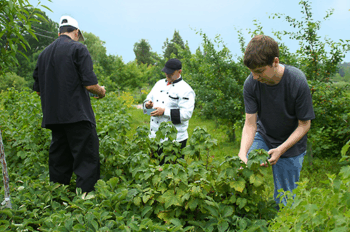
Chefs and intern on Cross Island Farms. Photo: Dani Baker
Practical Management and Crop Selection
Dani has developed a highly efficient system for managing her U-pick operation:
- Appointments Only: To control harvest volume and avoid overselling
- Pre-measured Containers: Fixed pricing with pint and quart containers for simplicity
- Selective Promotion: Minimal advertising, relying instead on word-of-mouth and a poster on her website
- Social Media Use: Posting on Facebook to generate interest when there’s an abundance of a particular fruit
Her approach allows her to balance quality control with customer experience, while maintaining a focus on providing a unique, educational experience rather than bulk harvesting for preservation.
Financial Considerations
While Dani acknowledges that the edible forest represents a long-term capital investment and is not yet fully profitable, her U-pick model provides a consistent revenue stream with minimal labor. Most of the labor-intensive work, such as pruning and mulching, occurs during the off-season, allowing her to balance expenses and revenue more effectively.
Risk Management and Insurance
Dani has taken thoughtful steps to minimize risk and ensure visitor safety. Her U-pick liability insurance costs $139 per year, a rate she attributes to working with an agent experienced in farm policies. She has implemented safety measures, including railings near ponds, supervision requirements for children, and clearly stated rules like “no running.” Dani wittily suggests, “Have a 2-year-old walk around your venue—they will find every hazard you need to address.” This advice encourages farmers to thoroughly assess their spaces for safety risks.
Key Takeaways and Advice
Reflecting on her experience, Dani emphasizes the importance of these considerations:
- Charging a small admission fee to reduce freeloading
- Using appointment-only scheduling to manage customer flow and crop availability
- Avoiding ladder use for tree fruit by offering extension tools instead
She highlights that most labor occurs outside peak tourist months, making the model manageable. Above all, Dani finds joy in sharing her farm with the community, observing customers’ excitement as they explore new fruits and berries, and appreciating the hands-on connection to food and nature.
Dani’s U-pick serves as a powerful example of how a thoughtfully designed agritourism model can balance workload, revenue, and community connection while staying true to the farm’s core values of education and sustainability.
Developing a Business Plan
A well-defined business plan is the foundation of any successful agritourism venture. It acts as a roadmap, outlining your goals, strategies, and actions needed to bring your vision to life. A business plan not only provides clarity and direction, helping you make informed decisions, but also serves as a risk management tool, allowing you to assess potential challenges and develop contingency plans. Furthermore, when you are seeking funding from investors or lenders, a comprehensive business plan is crucial for demonstrating the viability and potential profitability of your agritourism operation.
| Component | Description |
|---|---|
| Executive Summary | A concise overview of the entire business plan, summarizing key aspects such as your business concept, market analysis, and financial projections |
| Business Overview | Details about your agritourism business, including your mission statement, business goals, and a description of your farm and its offerings |
| Market Analysis | A thorough analysis of the agritourism market, including your target audience, competitors, and growth opportunities |
| Products and Services | Description of the core agritourism experiences you offer, such as farm tours, educational workshops, or farm stays |
| Sales and Marketing Strategies | Outline of how you plan to attract and retain customers, including your marketing channels, pricing strategies, and promotional activities |
Financial Plan
A comprehensive financial plan is crucial for securing funding and making informed business decisions.
- Revenue Projections: Estimate your potential revenue based on factors such as the number of visitors, pricing, and the types of activities you offer.
- Expense Estimates: Identify and quantify your expenses, including startup costs, operating expenses, and marketing costs.
- Key Financial Metrics: Calculate key financial metrics, such as Internal Rate of Return (IRR) and Net Present Value (NPV), to assess the profitability and long-term viability of your agritourism business.
- Funding Sources: Explore various funding options, such as grants, loans, and private investments, to secure the necessary capital for your agritourism venture.
While agritourism presents exciting opportunities, it’s important to acknowledge the challenges of profitability in this field. A significant percentage of agritourism farms report low profits, highlighting the importance of careful planning, cost management, and effective marketing to achieve financial success.
Marketing Strategies
Understanding Your Target Audience
Identifying and understanding your target audience is essential for tailoring your agritourism offerings and marketing efforts effectively. Consider these factors when analyzing your target audience:
- Demographics: Age, gender, income, education, and family status can influence visitors’ interests and preferences.
- Motivations: Why are visitors interested in agritourism? Are they seeking educational experiences, family fun, or a connection with nature?
- Values: What are the values and priorities of your target audience? Are they interested in sustainability, local food, or supporting small farms?
- Efficient Resource Allocation: Once you’ve identified your target audience, use your resources efficiently to cater to their needs and preferences. This may involve marketing through channels they frequent or improving access to community activities that appeal to them.
By understanding your target audience, you can develop agritourism experiences that meet their needs and price those offerings accordingly. For example, families with young children might be more price-sensitive and interested in activities like petting zoos and hayrides, while other adults might be willing to pay more for farm-to-table dining or educational workshops.
Digital Marketing
Attracting visitors to your agritourism business requires a strong online presence and effective digital-marketing strategies. Here are some key areas to focus on:
Website: A user-friendly website acts as your digital storefront, providing essential information about your farm, activities, pricing, and booking options. Use it to showcase the unique aspects of your farm and the experiences you offer.
- Social Media: Platforms like Facebook, Instagram, and Pinterest are invaluable for sharing engaging content, interacting with potential visitors, and building a community around your agritourism brand. Share high-quality photos and videos that capture the beauty of your farm and the activities available. Respond to comments and messages promptly, fostering a sense of community and building relationships with potential visitors.
- Online Travel Agencies: Listing your experiences on online travel agencies can significantly expand your reach and attract a wider audience.
- Email Marketing: Build an email list and use it to stay connected with past and potential visitors. Share updates, promotions, and upcoming events to keep them engaged.
- Technology Integration: Embrace technology to enhance the visitor experience and streamline your operations. Consider incorporating virtual tours to give potential visitors a preview of your farm and
online booking systems to simplify the reservation process.
Word-of-Mouth Marketing
Although digital marketing is essential, don’t underestimate the power of word-of-mouth marketing. Positive word-of-mouth can be a powerful driver of business, especially in a service-oriented industry like agritourism.
- Exceptional Experiences: Strive to create memorable experiences that exceed customer expectations. Happy visitors are more likely to share their positive feedback with friends and family, leading to increased bookings and brand awareness.
- Community Engagement: Participate in local events and partner with nearby businesses, such as hotels, restaurants, and tour operators, to cross-promote each other’s offerings and attract a wider audience.
- Social Media Contests: Encourage user-generated content and word-of-mouth marketing by hosting contests and giveaways on social media. Ask visitors to share photos or stories of their experiences on your farm for a chance to win a prize.
Seasonal Planning and Unique Farm Experiences
Agritourism often operates in seasonal cycles, with particular activities tied to specific times of the year, such as harvest festivals in the fall or U-pick berry farms in the summer. Planning for seasonality is crucial for maximizing your revenue and ensuring a consistent flow of visitors throughout the year. Here are some tips for creating a unique farm experience:
- Diversify Your Offerings: Offer a variety of activities to cater to different interests and age groups. Consider options like farm tours, hayrides, U-pick operations, petting zoos, corn mazes, and farm-to-table dining experiences.
- Embrace Authenticity: Showcase the unique character of your farm and its agricultural practices. Offer hands-on experiences that allow visitors to connect with the land and learn about where their food comes from.
- Create a Welcoming Atmosphere: Ensure your farm is clean, safe, and easily accessible. Provide clear signage, comfortable seating areas, and amenities like restrooms and hand-washing stations.
- Offer Educational Opportunities: Incorporate educational elements into your activities, such as guided tours, workshops, or demonstrations. This can enhance the visitor experience and provide valuable learning opportunities.
- Promote Sustainability: Highlight your farm’s commitment to environmental stewardship and sustainable practices. This can attract environmentally conscious visitors and differentiate your agritourism business.
- Embrace Agritourism Trends: Stay current with emerging trends in agritourism, such
as wellness retreats, glamping, and farm stays. Incorporating these trends can enhance the visitor experience and attract new groups of customers. - Prioritize Customer Experience: Focus on exceeding customer expectations and creating memorable experiences. Positive customer experiences can lead to repeat business, positive reviews, and valuable word-of-mouth marketing.
Pricing Strategies for Agritourism Experiences
Setting the right prices for your agritourism experiences is crucial for profitability and customer satisfaction. Consider these factors when developing your pricing strategy:
- Costs: Calculate your fixed and variable costs for each activity to ensure your prices cover expenses and generate a profit.
- Customers: Understand your target audience and their willingness to pay for different experiences. Consider offering tiered pricing options to cater to different budgets.
- Competition: Research the prices of similar agritourism businesses in your area to ensure your offerings are competitive.
- Value: Clearly communicate the value of your experiences to justify your pricing. Highlight the unique aspects of your farm and the educational opportunities you provide.
- Break-Even Analysis: Conduct a break-even analysis to determine the minimum number of participants or sales needed to cover your costs for each activity. This will help you set prices that ensure profitability.
Funding Opportunities for Agritourism Ventures
Starting an agritourism business may require initial investments in infrastructure, marketing, or equipment. Fortunately, various funding opportunities are available to support
agritourism ventures.
Federal Funding
- USDA Value-Added Producer Grants: These grants assist agricultural producers in entering value-added activities, including agritourism, to generate new products, create and expand marketing opportunities, and increase producer income.
- Rural Energy for America Program (REAP): This program provides grants and loan guarantees to agricultural producers and rural small businesses for renewable energy systems and energy-efficiency improvements.
- USDA Farm Loans: The Farm Service Agency (FSA) offers direct and guaranteed loans to family-size farmers and ranchers for various purposes, including farm ownership, operating expenses, and emergency situations.
State Funding
Many states offer grants to support tourism development, including agritourism initiatives. These grants may fund marketing campaigns, infrastructure improvements, or workforce development programs. Examples of these include the following:
- North Carolina AgVentures Grant: This program provides cost-share grants to North Carolina family farms to diversify, expand, or enhance their agricultural operations, including agritourism.
- Tennessee Department of Agriculture Producer Diversification Program: This program offers cost-share opportunities for agritourism ventures in Tennessee.
- Montana Department of Commerce Agritourism Grant Program: This program offers grants to rural and tribal farming enterprises to provide support and promote diversification in Montana.
Private Funding
- Private Investors: Seek out private investors, including local tourism agencies and community foundations, who are interested in supporting sustainable agriculture and rural development.
- Crowdfunding: Explore crowdfunding platforms to raise capital from individuals who are passionate about agritourism.
Agritourism Trends and Future Outlook
Growth of Agritourism Post-COVID-19
Agritourism has experienced significant growth in the wake of the COVID-19 pandemic, as consumer behavior shifted towards local tourism and outdoor experiences. With travel restrictions and safety concerns limiting long-distance travel, many people turned to local farms for safe, outdoor activities. This trend led to increased interest in U-pick farms, farm stays, and other hands-on experiences, helping farms diversify revenue streams while meeting consumer demand for experiential travel (Callahan, 2023).
Sustainable Agritourism
Sustainable practices in agritourism not only support environmental health but also enhance the visitor experience by aligning with consumer values. Implementing regenerative agriculture principles, such as cover cropping, composting, and minimal soil disturbance, offers educational opportunities for guests while preserving the land. Farms that emphasize sustainability often find increased visitor engagement and customer loyalty, as consumers become more aware of the importance of supporting eco-friendly operations (Reganold and Wachter, 2016).
Agritourism has the potential to be a powerful tool for boosting farm income and strengthening community engagement. By offering experiences such as U-pick harvests, farm stays, and educational workshops, farms can diversify their income while building deeper connections with their local community. However, successful agritourism ventures require thoughtful planning, risk management, and alignment with the farm’s long-term goals. As the industry continues to grow, embracing sustainable practices and community-focused initiatives will be key to long-term success (USDA, 2020b).
Conclusion
Agritourism is an evolving field, with changing consumer preferences and emerging trends shaping its future. Adapting to these changes and exceeding customer expectations are crucial for long-term success. By embracing innovation, prioritizing sustainability, and fostering a deep connection between visitors and the agricultural world, agritourism can play a vital role in promoting sustainable agriculture and rural development.
Agritourism has the potential to transform farms into educational, community-driven hubs while providing economic resilience and diverse revenue streams. By incorporating sustainable practices and offering engaging visitor experiences, farms can create a meaningful impact on their local economies while strengthening community ties.
If you’re considering starting or expanding your own agritourism venture, educating yourself on best practices and leveraging available resources is key. NCAT provides a wealth of educational materials, technical assistance, and guidance to help farmers succeed in agritourism. Reach out to NCAT or explore the listed resources to take the next steps in creating a thriving, resilient agritourism operation that benefits both your farm and your community.
References
Callahan, Rachael. 2023. How agritourism helped farmers during the pandemic. California Agriculture 77.
Farm Commons. 2018. Checklist for Managing Your Food Safety Liability.
Farm Commons. No date. Insurance and Liability.
Holladay, Patrick J., Pablo Méndez-Lázaro, Heriberto Marin Centeno, Ralph Rivera-Gutierrez, Keenan Adams, and Katja Brundiers. 2019. Utuado, Puerto Rico and community resilience post-Hurricane Maria: The case of Tetuan reborn. Recreation, Parks, and Tourism in Public Health. Vol. 3. p. 5–16.
Holladay, Patrick J., Pablo Méndez-Lázaro, and Katja Brundiers. 2021. From hurricanes to pandemics: Community-based transformation and destination resilience in Utuado, Puerto Rico. Journal of Sustainability and Resilience. Vol. 1, No. 2. Article 1.
National AgrAbility Project. No date. Accessible Farming Design Solutions.
Reganold, John P., and Jonathan M. Wachter. 2016. Organic agriculture in the Twenty-First Century. Nature Plants. Vol. 2. p. 15221.
Retzlaff, Rebecca. 2004. Agritourism zoning down on the farm. Zoning Practice. March.
United States Department of Agriculture, Food and Nutrition Service (USDA). 2019. Agricultural Education Resources for Schools.
United States Department of Agriculture, Rural Development (USDA). 2020a. Value-Added Producer Grant Overview.
United States Department of Agriculture, Economic Research Service (USDA). 2020b. Agritourism Trends and Economic Impact Report.
Weingarten, Kasey, Katja Brundiers, Patrick J. Holladay, Pablo Méndez-Lázaro, and Connor Y.H. Wu. 2023. A visual-spatial inventory of agritourism assets in Central Puerto Rico to leverage sustainable regional development after the hurricane disaster. Journal of Responsible Tourism Management. Vol. 3, No. 1. p. 56–78.
Further Resources
Agritourism Resources by State
To find agritourism resources specifically for your state, visit the state Department of Agriculture and Tourism Department websites. In addition, agritourism resources are often available from a state’s Farm Bureau, and many states have an Agritourism Association.
Farm-Based Education Network
farmbasededucation.org
Grants and Programs
National Sustainable Agriculture Coalition (NSAC)
Local Food Safety Collaborative
National Farmers Union
National AgrAbility Project
agrability.org
National Children’s Center for Rural and Agricultural Health and Safety
Marshfield Clinic Research Institute
This publication is produced by the National Center for appropriate Technology through the ATTRA Sustainable Agriculture program, under a cooperative agreement with USDA Rural Development.
Roots to Revenue: Making Agritourism Work for Your Farm
By Gabriella Soto-Velez and Hakeem Holmes, NCAT Agriculture Specialists
May 2025
IP665

